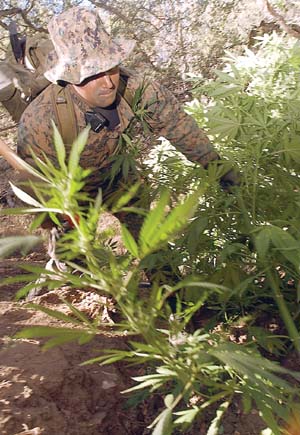
San Benito County
– They sat undetected for months. Their emerald stalks gradually
growing taller, growing fuller – their illicit fruit blossoming
into shiny, profitable buds.
San Benito County – They sat undetected for months. Their emerald stalks gradually growing taller, growing fuller – their illicit fruit blossoming into shiny, profitable buds.
But over 1,550 marijuana plant’s pungent existence came to an abrupt end with San Benito County sheriff’s deputies and drug enforcement agents’ swift sickle swipes on Thursday and Friday.
In a tactical operation, deputies with the sheriff department’s high-risk team and United Narcotics Enforcement Team agents eradicated seven marijuana plots containing over 3,000 pounds of marijuana with an estimated street value of $3.7 million on a ranch located in south San Benito County.
With more than a month left in the marijuana-growing season, agents have seized over 17,000 plants in the past few months, according to UNET Commander Mark Colla.
After months of work and thousands of pounds of pot confiscated, the team is still targeting about six other sites in San Benito County, Colla said.
The plots, located in two large gardens, were spotted by helicopter on Wednesday, said pilot Fred Young. There are several different areas in the county which are continuously used for marijuana growing, he said.
Officers discovered the gardens during an aerial search when they spotted a water line weaving through a dry creek bed that shouldn’t have been there, Young said.
Officers followed the hose through a canyon and found a trail that led them to the gardens, he said.
When searching for gardens, officers look for anything out of the ordinary that catches their eye, Young said.
“Sometimes they make a mistake and use a white fertilizer bag they forget to cover up, or something that shines,” he said. “Once in a while we’re lucky and we get people running through the brush.”
After locating the plots, six UNET agents and six sheriff’s officers camped out at the secluded ranch. They rose hours before daybreak on Thursday and entered the garden on foot while being guided by Young’s eagle eye from above.
Clad in head-to-toe camouflage and toting guns, machetes, sickles and other tools, the officers scaled boulders and climbed near vertical inclines to reach the most remote plots.
Before entering each plot, agents secured the gardens to make sure there were no traps or pistol-packing planters still lingering nearby.
Trekking over miles of hilly landscape, they chopped down every plant they found, carrying bundles worth thousands of dollars under their arms to be inventoried, stacked and destroyed.
On the first day more than 500 plants were seized and buried. The officer’s second day netted 1,000 more plants, Colla said.
While officers found camp sites of the people tending the gardens, no arrests were made because they likely fled, Colla said.
Most of the people tending the gardens are Mexican illegal aliens, working for Mexican drug cartels, Colla said.
Depending on the size of the garden and whether it’s successfully cultivated, they are paid between $3,000 and $5,000 for a crop worth millions on the street, he said.
Tenders can be nearly impossible to track and capture in the dense brush if agents don’t get a jump on them right away, Young said.
Because they live in the gardens for months at a time, they know the area intimately and have hiding places and escape routes, he said.
“These guys can go up the hill like goats,” Young said. “They’re unbelievable.”
While arrests are a bonus, possibly allowing agents to track them back to a cartel, they’re not always guaranteed, Colla said. But destroying millions of dollars worth of marijuana is still worth the effort, he said.
The rural area near the ranch has been a prime spot for marijuana growers for years, according to ranch manager Gilles Ruel.
In 1999, when a whopping 900,000 plants were eradicated throughout the county, more than 25,000 plants were found at the ranch alone, Ruel said.
Last year plants weren’t found, and Ruel believes growers took some time off from cultivating the area because it was becoming a hot spot, he said.
“Here we go again,” Ruel said. “They’re back.”
Sheriff’s Detective Sgt. Wes Walker said there’s no way to know how many other gardens remain undiscovered.
“It’s so dense and tough to find,” he said. “They go to great lengths to try to hide the gardens.”
Colla agreed, but said there is a good chance most are eradicated because there’s only so much water available to grow the plants in the areas they search.
“It’s a great feeling. Nobody got injured (on this raid) and we’re able to get dope off the streets,” he said. “It makes a great impact on future generations.”
Erin Musgrave can be reached at 637-5566, ext. 336, or at
em*******@***********ws.com.









